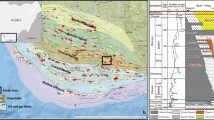Abstract.
This study reports the results of interdisciplinary investigations of Tournaisian deposits from the German Rheinisches Schiefergebirge and provides a genetic and sequence stratigraphic interpretation. Microfacies and geochemical data confirm normal marine outer shelf to slope environments for the Lower Tournaisian Hangenberg Formation. In contrast, data from the condensed, phosphatic "Liegender Alaunschiefer" black shale indicate low current energy and anoxic conditions in the sediment and the water column. We suggest that anoxia was caused by eutrophication and high organic productivity due to factors such as upwelling, a climate-related improvement of oceanic ventilation, and volcanic nutrient input. The Hangenberg Formation represents the lowstand through the early transgressive systems tract of a third-order depositional sequence, while the "Liegender Alaunschiefer" is a late transgressive systems tract and maximum flooding deposit. The Richrath Limestone was deposited during the highstand systems tract. Thus, quickly rising sea level and eutrophication may account for the peculiar and uniform facies of the "Liegender Alaunschiefer".
Similar content being viewed by others
Author information
Authors and Affiliations
Additional information
Electronic Publication
Rights and permissions
About this article
Cite this article
Siegmund, H., Trappe, J. & Oschmann, W. Sequence stratigraphic and genetic aspects of the Tournaisian "Liegender Alaunschiefer" and adjacent beds. Int J Earth Sci (Geol Rundsch) 91, 934–949 (2002). https://doi.org/10.1007/s00531-001-0252-9
Received:
Accepted:
Issue Date:
DOI: https://doi.org/10.1007/s00531-001-0252-9




